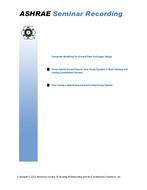Heat transfer and pressure drop data were taken during condensation of Refrigerant-113 and 150-SUS napthenic mineral oil mixtures inside smooth and internally finned tubes. Mixtures with oil concentrations of 1.2%, 2.8%, and 4.0% by weight. In addition to pure refrigerants, were tested. The data were collected from three sets of tube-in-tube, counterflow test condensers where the test fluid condensed inside the inner tube and the cooling water flowed in the annulus. Each set has two condensers. Within each set, the inner-tube of one of the condensers had fins on the inside, while the other had a smooth surface. Both tubes had the same outside diameter. The inner tubes of the three sets had different outside diameters and geometric fin parameters. The presence of oil resulted in a reduction in the heat transfer coefficient for both smooth and internally finned tubes. These reductions were approximately 7%, 12%, and 16% for oil concentrations of 1.2%, 2.8%, and 4.0%, respectively, for both smooth and internally finned tubes. The heat transfer for both oil-free and refrigerant-oil mixtures was enhanced by internal fins. This enhancement was in the range of 25% to 85%. Internal fins increased the pressure drop of both oil-free and refrigerant-oil mixtures in the range of 75% to 480% over the smooth tube results. However, the presence of oil has little effect on pressure drop for all tubes tested.
KEYWORDS: oils, heat flow, pressure drop, condensation, R113, finned tubes, tubes, heat transfer fluids, condensers, refrigerants, testing, comparing, performance
Citation: ASHRAE Transactions, vol.97, Pt. 1, New York 1991
Product Details
- Published:
- 1991
- Number of Pages:
- 9
- File Size:
- 1 file , 1.1 MB
- Product Code(s):
- D-18350


